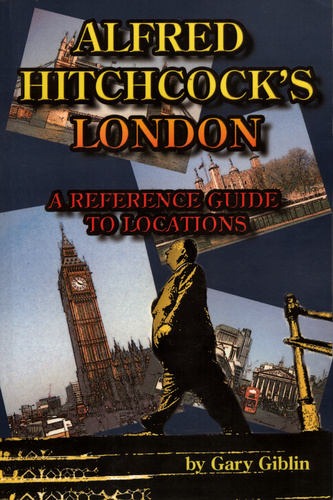Alfred Hitchcock's London: A Reference Guide to Locations (2009) by Gary Giblin
 | |
| Gary Giblin | |
| Midnight Marquee Press (2009) | |
| ISBN 188766467X (paperback) | |
| Amazon Online Reader | |
Product Links
Synopsis
Good evening, ladies and gentlemen. Tonight you are going to visit one of the world's most famous cities. Here you will see historic palaces, elegant hotels, and magnificent restaurants. If you're lucky, you may even see a corpse floating down the Thames. For tonight we shall visit: ALFRED HITCHCOCK'S LONDON. Now you can follow in the footsteps of the most famous film director of all time, from the corridors of Scotland Yard and the stalls of the Royal Albert Hall to the top of Tower Bridge and the dome of St. Paul's Cathedral. There was a hardly a corner of London that Hitchcock didn't visit and they're all here — over 200 of them — from the site of his birth in 1899 to the cathedral where he was memorialized in 1980.
Reviews
I read Gary Giblin's 'Alfred Hitchcock's London: A Reference Guide to Locations' from cover to cover, and had an enjoyable time doing it. I learnt a lot about individual films and often came to feel closer to both them and to Hitchcock-the-Englishman. Anglophile Giblin is also the author of 'James Bond's London' (2002) and he knows what he is writing about. He has seen all of the films and has read the literary texts on which they were based. He visited, and photographed, the hundreds of locations mentioned in his book. Plus he did research at such places as the British Film Institute, London, and the Margaret Herrick Library, Beverly Hills, where he consulted screenplays and production notes. And he also interviewed people who had worked with Hitchcock or were close to him. One highlight of the book isn't about a London location at all: the Cumberland (Cumbria) exteriors in THE PARADINE CASE. Giblin has found the exact site of just about every shot brought back by a second unit and used in the film. As he says, the shots are 'literally all over the map' — 50 miles apart in some cases — but convincingly edited together for the continuity Hitchcock required. I was interested to learn that Keane's/Gregory Peck's buggy ride to 'Hindley Hall' (which was actually, and is still, the Langdale Chase hotel) incorporated several picturesque landmarks, such as the Yew Tree Farm (you can rent a cottage there for £18 per day!). In sum: this is a book that you should own if you are serious about Hitchcock's films. And if you can make the trips to the locations themselves, so much the better!
— Ken Mogg (Amazon review)
